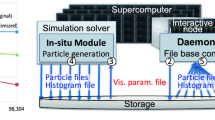
Access this book
Tax calculation will be finalised at checkout
Other ways to access
About this book
Prevalent types of data in scientific visualization are volumetric data, vector field data, and particle-based data. Particle data typically originates from measurements and simulations in various fields, such as life sciences or physics. The particles are often visualized directly, that is, by simple representants like spheres. Interactive rendering facilitates the exploration and visual analysis of the data. With increasing data set sizes in terms of particle numbers, interactive high-quality visualization is a challenging task. This is especially true for dynamic data or abstract representations that are based on the raw particle data.
This book covers direct particle visualization using simple glyphs as well as abstractions that are application-driven such as clustering and aggregation. It targets visualization researchers and developers who are interested in visualization techniques for large, dynamic particle-based data. Its explanations focus on GPU-accelerated algorithms for high-performance rendering and data processing that run in real-time on modern desktop hardware. Consequently, the implementation of said algorithms and the required data structures to make use of the capabilities of modern graphics APIs are discussed in detail. Furthermore, it covers GPU-accelerated methods for the generation of application-dependent abstract representations. This includes various representations commonly used in application areas such as structural biology, systems biology, thermodynamics, and astrophysics.
Similar content being viewed by others
Table of contents (9 chapters)
Authors and Affiliations
About the authors
Bibliographic Information
Book Title: Interactive GPU-based Visualization of Large Dynamic Particle Data
Authors: Martin Falk, Sebastian Grottel, Michael Krone, Guido Reina
Series Title: Synthesis Lectures on Visualization
DOI: https://doi.org/10.1007/978-3-031-02604-1
Publisher: Springer Cham
eBook Packages: Synthesis Collection of Technology (R0), eBColl Synthesis Collection 7
Copyright Information: Springer Nature Switzerland AG 2017
Softcover ISBN: 978-3-031-01476-5Published: 02 October 2016
eBook ISBN: 978-3-031-02604-1Published: 31 May 2022
Series ISSN: 2159-516X
Series E-ISSN: 2159-5178
Edition Number: 1
Number of Pages: XII, 109
Topics: Visualization, Data Structures and Information Theory, Data Mining and Knowledge Discovery



